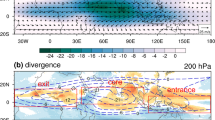Abstract
Based on the historical and RCP8.5 runs of the multi-model ensemble of 32 models participating in CMIP5, the present study evaluates the formation mechanisms for the patterns of changes in equatorial Pacific SST under global warming. Two features with complex formation processes, the zonal El Ni˜no-like pattern and the meridional equatorial peak warming (EPW), are investigated. The climatological evaporation is the main contributor to the El Ni˜no-like pattern, while the ocean dynamical thermostat effect plays a comparable negative role. The cloud–shortwave-radiation–SST feedback and the weakened Walker circulation play a small positive role in the El Ni˜no-like pattern. The processes associated with ocean dynamics are confined to the equator. The climatological evaporation is also the dominant contributor to the EPW pattern, as suggested in previous studies. However, the effects of some processes are inconsistent with previous studies. For example, changes in the zonal heat advection due to the weakened Walker circulation have a remarkable positive contribution to the EPW pattern, and changes in the shortwave radiation play a negative role in the EPW pattern.
Similar content being viewed by others
References
An, S.-I., and S.-H. Im, 2014: Blunt ocean dynamical thermostat in response of tropical eastern Pacific SST to global warming. Theor. Appl. Climatol., 118, 173–183.
Bjerknes, J., 1969: Atmospheric teleconnections from the equatorial Pacific. Mon. Wea. Rev., 97, 163–172.
Cane, M. A., and Coauthors, 1997: Twentieth-century Sea surface temperature trends. Science, 275, 957–960.
Clement, A. C., R. Seager, M. A. Cane, and S. E. Zebiak, 1996: An ocean dynamical thermostat. J. Climate, 9, 2190–2196.
Collins, M., 2005: El Niño- or La Niña-like climate change? Climate Dyn., 24, 89–104.
DiNezio, P. N., A. C. Clement, G. A. Vecchi, B. J. Soden, B. P. Kirtman, and S.-K. Lee, 2009: Climate response of the equatorial Pacific to global warming. J. Climate, 22, 4873–4892.
Du, Y., and S.-P. Xie, 2008: Role of atmospheric adjustments in the tropical Indian ocean warming during the 20th century in climate models. Geophys. Res. Lett., 35, L08712.
Held, I. M., and B. J. Soden, 2006: Robust responses of the hydrological cycle to global warming. J. Climate, 19, 5686–5699.
Huang, P., 2015: Seasonal changes in tropical SST and the surface energy budget under global warming projected by CMIP5 models. J. Climate, 28, 6503–6515.
Huang, P., and J. Ying, 2015: A multimodel ensemble pattern regression method to correct the tropical Pacific SST change patterns under global warming. J. Climate, 28, 4706–4723.
Huang, P., S.-P. Xie, K. M. Hu, G. Huang, and R. H. Huang, 2013: Patterns of the seasonal response of tropical rainfall to global warming. Nature Geoscience, 6, 357–361.
Huang, P., I.-I. Lin, C. Chou, and R. H. Huang, 2015: Change in ocean subsurface environment to suppress tropical cyclone intensification under global warming. Nature Communications, 6, 7188.
Knutson, T. R., and S. Manabe, 1995: Time-mean response over the tropical Pacific to increased CO2 in a coupled oceanatmosphere model. J. Climate, 8, 2181–2199.
Knutson, T. R., J. J. Sirutis, S. T. Garner, G. A. Vecchi, and I. M. Held, 2008: Simulated reduction in Atlantic hurricane frequency under twenty-first-century warming conditions. Nature Geoscience, 1, 359–364.
Liu, Z. Y., S. Vavrus, F. He, N. Wen, and Y. F. Zhong, 2005: Rethinking tropical ocean response to global warming: The enhanced equatorial warming. J. Climate, 18, 4684–4700.
Ma, J., S.-P. Xie, and Y. Kosaka, 2012: Mechanisms for tropical tropospheric circulation change in response to global warming. J. Climate, 25, 2979–2994.
Ma, J., and S.-P. Xie, 2013: Regional patterns of Sea surface temperature change: A source of uncertainty in future projections of precipitation and atmospheric circulation. J. Climate, 26, 2482–2501.
Ma, J., and J.-Y. Yu, 2014: Linking centennial surface warming patterns in the equatorial Pacific to the relative strengths of the Walker and Hadley circulations. J. Atmos. Sci., 71, 3454–3464.
Meehl, G. A., and W. M. Washington, 1996: El Niño-like climate change in a model with increased atmospheric CO2 concentrations. Nature, 382, 56–60.
Ramanathan, V., and W. Collins, 1991: Thermodynamic regulation of ocean warming by cirrus clouds deduced from observations of the 1987 El Niño. Nature, 351, 27–32.
Seager, R., and R. Murtugudde, 1997: Ocean dynamics, thermocline adjustment, and regulation of tropical SST. J. Climate, 10, 521–534.
Song, X. L, and G. J. Zhang, 2014: Role of climate feedback in El Niño-like SST response to global warming. J. Climate, 27, 7301–7318.
Sun, D.-Z., J. Fasullo, T. Zhang, and A. Roubicek, 2003: On the radiative and dynamical feedbacks over the equatorial Pacific cold tongue. J. Climate, 16, 2425–2432.
Sun, D. Z., and Coauthors, 2006: Radiative and dynamical feedbacks over the equatorial cold tongue: Results from nine atmospheric GCMs. J. Climate, 19, 4059–4074.
Taylor, K. E., R. J. Stouffer, and G. A. Meehl, 2012: An overview of CMIP5 and the experiment design. Bull. Amer. Meteor. Soc., 93, 485–498.
Vecchi, G. A., and B. J. Soden, 2007: Global warming and the weakening of the tropical circulation. J. Climate, 20, 4316–4340.
Xie, S.-P., and S. G. H. Philander, 1994: A coupled oceanatmosphere model of relevance to the ITCZ in the eastern Pacific. Tellus A, 46, 340–350.
Xie, S.-P., C. Deser, G. A. Vecchi, J. Ma, H. Y. Teng, and A. T. Wittenberg, 2010: Global warming pattern formation: Sea surface temperature and rainfall. J. Climate, 23, 966–986.
Zhang, L., and T. Li, 2014: A simple analytical model for understanding the formation of Sea surface temperature patterns under global warming. J. Climate, 27, 8413–8421.
Author information
Authors and Affiliations
Corresponding author
Rights and permissions
About this article
Cite this article
Ying, J., Huang, P. & Huang, R. Evaluating the formation mechanisms of the equatorial Pacific SST warming pattern in CMIP5 models. Adv. Atmos. Sci. 33, 433–441 (2016). https://doi.org/10.1007/s00376-015-5184-6
Received:
Revised:
Accepted:
Published:
Issue Date:
DOI: https://doi.org/10.1007/s00376-015-5184-6




